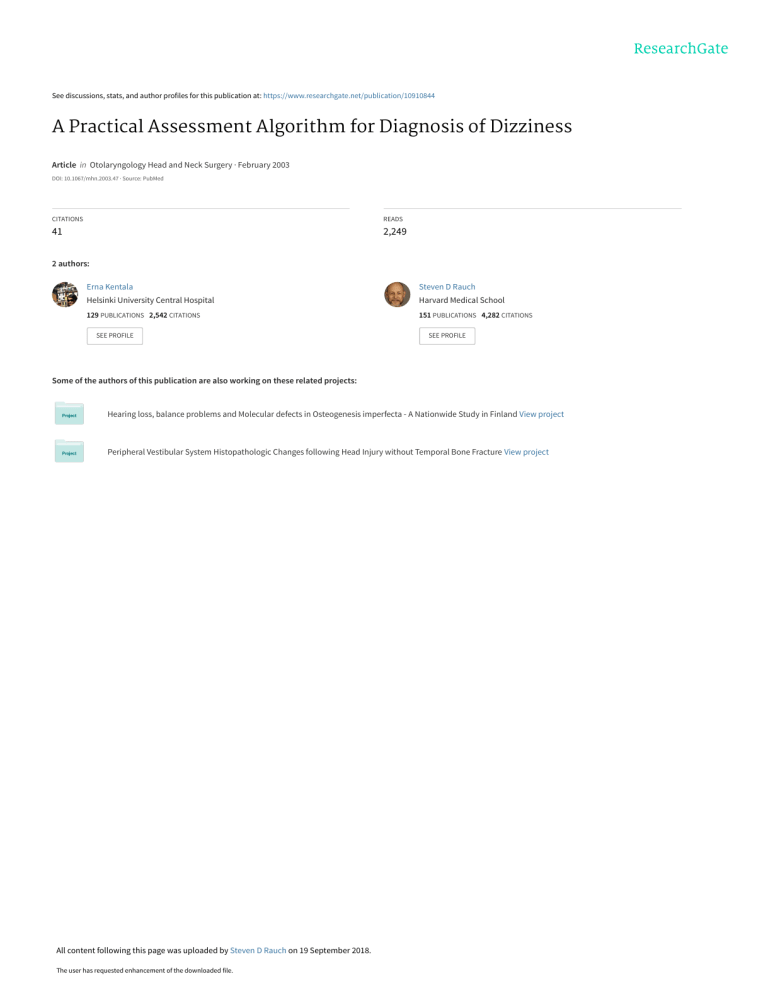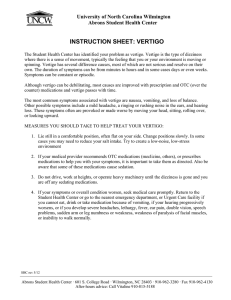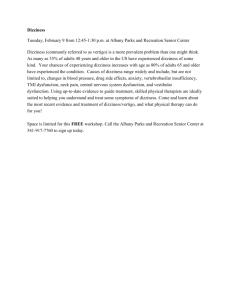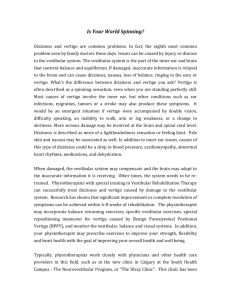
See discussions, stats, and author profiles for this publication at: https://www.researchgate.net/publication/10910844 A Practical Assessment Algorithm for Diagnosis of Dizziness Article in Otolaryngology Head and Neck Surgery · February 2003 DOI: 10.1067/mhn.2003.47 · Source: PubMed CITATIONS READS 41 2,249 2 authors: Erna Kentala Steven D Rauch Helsinki University Central Hospital Harvard Medical School 129 PUBLICATIONS 2,542 CITATIONS 151 PUBLICATIONS 4,282 CITATIONS SEE PROFILE SEE PROFILE Some of the authors of this publication are also working on these related projects: Hearing loss, balance problems and Molecular defects in Osteogenesis imperfecta - A Nationwide Study in Finland View project Peripheral Vestibular System Histopathologic Changes following Head Injury without Temporal Bone Fracture View project All content following this page was uploaded by Steven D Rauch on 19 September 2018. The user has requested enhancement of the downloaded file. A practical assessment algorithm for diagnosis of dizziness ERNA KENTALA, MD, and STEVEN D. RAUCH, MD, Boston, Massachusetts, and Helsinki, Finland OBJECTIVE: We sought to test a 3-parameter model for diagnosis of dizziness based on the type and temporal characteristics of the dizziness and on hearing status. STUDY DESIGN AND SETTING: We conducted a prospective blinded study at a tertiary referral neurotology practice. Before examination, patients completed a questionnaire reporting type and timing of dizziness symptoms and hearing status. Clinical diagnoses were compared with questionnaire results. RESULTS: Fifty-seven patients completed the questionnaire. We were able to correctly classify 21 (60%) of the 35 subjects who had a common otogenic cause of vertigo by the diagnostic algorithm. CONCLUSION: A simple classification of dizziness by type, timing, and hearing status can be selfreported by patients using a brief questionnaire. This classification scheme is as good as others of much greater complexity. SIGNIFICANCE: The simple classification scheme reported here is based on history alone and facilitates triage of dizzy patients into diagnostic groups for work-up and management. (Otolaryngol Head Neck Surg 2003;128:54-9.) D izziness is a common chief complaint and can be a symptom of a multitude of diseases. According to the National Institutes of Health National Institute of Deafness and Other Communication Disorders (NIDCD), approximately 40% of all Americans will seek medical attention for dizziness at some time in their lives. NIDCD also From the Department of Otology and Laryngology, Harvard Medical School, Boston (Drs Kentala and Rauch), Department of Otolaryngology, Massachusetts Eye and Ear Infirmary, Boston (Drs Kentala and Rauch), and the Department of Otology and Laryngology, Helsinki University Hospital, Helsinki (Dr Kentala). Presented at the Research Forum of the American Academy of Otolaryngology–Head and Neck Surgery, Denver, CO, September 9-12, 2001. Reprint requests: Steven D. Rauch, MD, Massachusetts Eye and Ear Infirmary, 243 Charles St, Boston, MA 02114; e-mail, sdr@epl.meei.harvard.edu. Copyright © 2003 by the American Academy of Otolaryngology–Head and Neck Surgery Foundation, Inc. 0194-5998/2003/$30.00 ⫹ 0 doi:10.1067/mhn.2003.47 54 reports that falls account for 50% of all accidental deaths in the elderly. Despite the obvious public health significance of dizziness, patients typically have great difficulty getting quality care for this complaint. They have trouble articulating the nature of the symptoms, the primary care and specialist physicians they see often have very limited knowledge of the vestibular system, there are no simple and readily available laboratory studies to make a dizzy diagnosis, and economic pressure on physicians to spend less time with more patients works against the patient with a complicated and time-consuming dizziness problem. It is certainly a universal perception among otolaryngologists that dizzy patients represent one of the most frustrating and frustrated groups of patients. Here, we present a very simple questionnaire to guide the physician in the initial triage of dizzy patients. This is by no means the first questionnaire developed for this purpose. However, we believe its combination of simplicity and efficacy distinguishes it from other methods. Traditionally, evaluation of a dizzy patient begins with a long and exhaustive interview, followed by a complex physical examination of both the ears and nervous system. Several authors have published their approach to evaluating a dizzy patient.1-7 Each emphasizes the value of a careful and thorough case history. Besides asking for symptoms and examining signs related to vertigo, the physician must take the case history of other diseases, to exclude possible trauma, exposure to toxic substances, and other factors.3 The most important questions to be considered are the duration and occurrence of vertigo, the aggravation of symptoms by head movement, and the auditory or neurologic symptoms associated with it.1,7 The usefulness of these questionnaires in clinical practice has not been tested (or published). A few expert systems have been developed to aid the diagnostic task with dizzy patients.8-10 These expert systems are computer algorithms that use information on frequency and duration of vertigo attack, characteristics of vertigo (spinning, floating), associated hearing loss, tinnitus, and Otolaryngology– Head and Neck Surgery Volume 128 Number 1 neurologic symptoms. In one such system this information is supplemented with results from otoneurologic and audiometric testing.7 Expert systems have both strong and weak points. They can handle large amounts of information and even uncertainty. However, at best, their diagnostic accuracy is around 65%, and input of all required information can be a time-consuming task.11 The key questions in differentiating otologic causes of dizziness are duration of hearing loss and tinnitus, frequency and duration of vertigo attacks, and occurrence of head injury in relation to the onset of symptoms.7 In questionnaire-based studies, neither questions concerning head positioning induced vertigo nor neurologic symptoms were among the most important questions.7 During the past decade, we developed a simple practical clinical assessment algorithm for dizzy patients. The approach is based on 3 parameters: the type of dizziness, the temporal characteristics of the dizziness, and the hearing status. This algorithm has been used for teaching as well as applied informally in the clinical setting for several years. The present prospective blinded study was undertaken to test the validity of using this 3-parameter model as the basis for a diagnostic classification scheme. MATERIALS AND METHODS We hypothesized (1) that a simple dizziness classification could enable us to focus on patients with high likelihood of otogenic dizziness, (2) that patients could self-classify, and (3) that combining the dizziness classification with information about the duration of symptoms and presence or absence of hearing loss would provide correct diagnoses. Clinically, we use a simple dizziness classification similar to that described by Froehling et al6 that categorizes dizziness into 4 “flavors”: near syncope, dysequilibrium, true vertigo, and psychogenic dizziness. Near syncope is the feeling of impending loss of consciousness. It represents inadequate cerebral perfusion. Common causes include postural hypotension, valvular heart disease or arrhythmia, and carotid stenosis. These patients are triaged to the internist or cardiologist. Dysequilibrium is a feeling of imbalance or impending fall. It can be further subdivided into gait dysequilibrium or global dysequilibrium. Pa- KENTALA and RAUCH 55 tients whose feeling of imbalance occurs exclusively during ambulation usually have neuromuscular or musculoskeletal problems affecting sensory or motor function of the legs. Examples include diabetic peripheral neuropathy, spinal stenosis, or cerebellar dysfunction. Such patients are referred to the neurologist. In contrast, global dysequilibrium is present all the time or is aggravated by any movement of the head or body (not just walking). These patients may have ear or neurologic disease and need an otologic work-up. True vertigo is defined as “a false sense of motion”: either you are moving or the world is moving about you. Whirling vertigo is a “special case” of vertigo just as a square is a special case of rectangles. Although rotatory or whirling vertigo is often caused by the inner ear, the ear can cause other movement sensations and the central nervous system can cause rotatory sensations. Patients with true vertigo need an otologic work-up. Psychogenic dizziness is a difficult issue. Most often, patients describe a “spacey” or “disconnected” dizziness without any feeling of motion or loss of balance. Dizzy patients are often anxious or depressed or belligerent, and these feelings may so dominate their behavioral style that the physician cannot see past them to the balance disorder. Although a psychiatric evaluation is indicated, psychiatric disease does not protect one from vestibulopathy and the otolaryngologist is well advised to continue the work-up. Subjects Fifty-seven patients (42 women and 15 men) referred to one of the authors (S.D.R.) for evaluation of dizziness in a tertiary referral setting completed the questionnaire. The mean age of subjects was 47 years (age range, 20 to 78 years). Procedures Because classification of the four “flavors” of dizziness is so straightforward, we proposed to let the patients do it themselves. A questionnaire was designed for this purpose (Appendix 1). This questionnaire seemed to offer an acceptable level of simplicity while minimizing ambiguity in the answers provided by the patients. A prospective blinded methodology was used. Consecutive newly referred dizzy patients were asked to com- Otolaryngology– Head and Neck Surgery January 2003 56 KENTALA and RAUCH Table 1. Diagnostic algorithm matrix True vertigo Hearing loss Episodic Persistent No Yes BPPV Meniere’s disease Vestibular neuritis Labyrinthitis Each cell of the 2 ⫻ 2 matrix represents a putative otogenic vertigo diagnosis. Patients are assigned to positions in the matrix depending on their self-report of vertigo and hearing loss on the questionnaire (see text for details). plete the dizziness questionnaire in which they self-report the type and timing of symptoms based on the brief definitions contained in the questionnaire text. The questionnaire focused first on true vertigo, and patients with this symptom were asked to characterize the duration of the symptom as episodic (short, medium, or long) versus persistent. Then patients were queried about the other flavors of dizziness and their respective duration. The questionnaire purposely has no question regarding symptoms produced by head position; because many patients believe that any head motion enhances their symptoms, asking about symptoms induced by head positioning could be misleading. Patient hearing status was assessed by a single question of whether they had hearing loss. Questionnaires were completed before seeing the otologist. The otologist was blinded to the questionnaire results and used patient history, clinical examination, and results of audiometric and otoneurologic tests for the diagnostic work-up. Subsequently, the otologist’s diagnosis for each patient was extracted from the medical record. Diagnostic classifications by the otologist and by analysis of the questionnaire were compared. Data Analysis Patients reporting true vertigo on their questionnaires were assigned presumptive diagnoses according to the diagnostic algorithm in Table 1, based on their self-report of dizziness type, duration, and hearing loss status. The 4 diagnoses in this diagnostic matrix (benign paroxysmal positional vertigo [BPPV], Meniere’s disease, vestibular neuritis, labyrinthitis) represent the 4 most common causes of otogenic vertigo. Classification into one of these 4 diagnostic groups was based only on the presence or absence of hearing loss and the duration of vertigo (episodic versus persistent). The accuracy of the diagnostic algorithm was assessed by comparing these presumptive diagnoses with the clinical diagnoses assigned by the otologist in his medical record, based on the assumption that an expert clinician with a nuanced history and discretionary access to any necessary clinical tests would give the “correct” diagnosis. Patients reporting dysequilibrium alone (without true vertigo) were analyzed separately to compare questionnaire results with otologic clinical diagnoses. RESULTS A definite clinical diagnosis was made by the otologist in 49 (86%) of 57 patients. The remaining 8 patients were given descriptive diagnoses or reported to have a presentation “suggestive of” a disease. According to the medical records, 35 (61.4%) of 57 subjects belonged to the four disease groups that could be classified by the diagnostic algorithm (BPPV, Meniere’s disease, labyrinthitis, vestibular neuritis). Of the remaining 22 subjects, 8 (14%) had migraine-associated dizziness, whereas the other 14 had a variety of other peripheral, central, or undiagnosed abnormalities. Each patient with true vertigo was assigned to a particular cell of the diagnostic algorithm matrix based on his or her self-report of vestibular symptoms and hearing loss. Patients with short-duration episodic vertigo and no hearing loss were assigned to the BPPV cell; intermediate-duration vertigo with hearing loss was assigned to the Meniere’s disease cell; persistent vertigo with hearing loss was assigned to the labyrinthitis cell; and persistent vertigo without hearing loss was assigned to the vestibular neuritis cell. Patients with intermediate-duration episodic vertigo and no hearing loss and patients with dysequilibrium but no vertigo were unclassifiable by the matrix. Table 2 contains a tabulation of all 41 subjects classified by the diagnostic algorithm matrix. For the 35 patients with clinical diagnoses of BPPV (n ⫽ 8), Meniere’s disease (n ⫽ 15), vestibular neuritis (n ⫽ 9), and labyrinthitis (n ⫽ 3), 21 (60%) were correctly classified/diagnosed by the simple 2 ⫻ 2 matrix shown in Table 1. The remaining 14 were either misclassified (i.e., they had 1 of the 4 putative diagnoses but were assigned to the wrong cell of the matrix) or unclas- Otolaryngology– Head and Neck Surgery Volume 128 Number 1 KENTALA and RAUCH 57 Table 2. Clinical diagnoses of subjects assigned to each cell of the diagnostic algorithm matrix True vertigo Hearing loss No Yes Episodic Persistent BPPV (4) Vertebrobasilar insufficiency (1) Cervical vertigo (1) Meniere’s disease (2) Vestibular neuritis (1) Total ⫽ 9 Meniere’s disease (11) Migraine-associated dizziness (1) BPPV (2) Vestibular neuritis (1) Labyrinthitis (1) Mal de debarquement (1) Episodic peripheral vertigo (1) Genetic inner ear degeneration (1) Total ⫽ 19 Vestibular neuritis (5) Utricular dysfunction (1) Migraine-associated dizziness (2) BPPV (1) Imbalance, not otogenic (1) Total ⫽ 10 Labyrinthitis (1) Closed head trauma (1) Otosclerosis dizziness syndrome (1) Total ⫽ 3 BPPV, Benign paroxysmal positional vertigo. In each cell, the first line represents those subjects correctly classified with the diagnostic algorithm. n values given in parentheses. sified (i.e., they did not fit in the matrix because of reporting intermediate-duration vertigo without hearing loss or dysequilibrium without true vertigo). Of 8 patients with BPPV, 4 (50%) were correctly classified, 2 (25%) were erroneously classified as having Meniere’s disease because they had unrelated hearing loss, 1 (12.5%) had vestibular neuritis, and 1 (12.5%) was unclassified, reporting hearing loss and fainting. Of 15 patients with Meniere’s disease, 11 (73.3%) were correctly classified, 2 (13.3%) were misclassified as BPPV because they were unaware of their hearing loss and erroneously reported it to be normal, and 2 (13.3%) were unclassified, reporting spaciness and/or dysequilibrium without true vertigo. Of 9 patients with vestibular neuritis, 5 (55.6%) were correctly classified, 1 (11.1%) was misclassified as Meniere’s disease because of unrelated hearing loss, 1 (11.1%) was misclassified as BPPV because of incorrect report of varying vertigo intensity as episodes, and 2 (22.2%) were unclassified because of reporting vertigo as a moderateduration episode rather than persistent. Of 3 patients with labyrinthitis, 1 (33.3%) was correctly classified, 1 (33.3%) was misclassified as Meniere’s disease because of reporting vertigo as episodes rather than persistent, and 1 (33.3%) was unclassified by having reported hearing loss and dysequilibrium without true vertigo. Migraine-associated dizziness (MAD) patients formed a fifth large clinical diagnostic group (8 of 57, or 14% of all subjects). Five of the 8 migraineurs (62.5%) were not classified by our algorithm. Their flavor of dizziness was most often dysequilibrium or moderate-duration episodes of true vertigo, without hearing loss. Two MAD patients (25%) were erroneously classified as having vestibular neuritis because their dizzy spells lasted longer. One MAD patient (12.5%) was misclassified as having Meniere’s disease because of unrelated hearing loss in addition to vertigo episodes. DISCUSSION This study set out to test the hypotheses that (1) a simple dizziness classification could enable the physician to focus on patients with high likelihood of otogenic dizziness, (2) that patients could selfclassify, and (3) that combining the dizziness classification with information about the duration of symptoms and presence or absence of hearing loss would give correct diagnoses. Of the 57 patients in the study, 35 had 1 of the 4 most common otogenic causes of dizziness, BPPV, Meniere’s disease, vestibular neuritis, or labyrinthitis. The simple 2 ⫻ 2 diagnostic algorithm matrix used to analyze questionnaire results correctly classified 60% (21 of 35) of these patients. This correct Otolaryngology– Head and Neck Surgery January 2003 58 KENTALA and RAUCH Table 3. Group assignment versus actual diagnosis True vertigo Hearing loss No Putative diagnosis Total No. in cell Correct assignment/correct diagnosis Correct assignment/different diagnosis Total correct assignments Yes Putative diagnosis Total No. in cell Correct assignment/correct diagnosis Correct assignment/different diagnosis Total correct assignments Episodic Persistent BPPV 9 (100) 4 (44.4) 2 (22.2) 6 (66.7) Vestibular neuritis 10 (100) 5 (50) 4 (40) 9 (90) Meniere’s disease 19 (100) 11 (57.9) 0 (0) 11 (57.9) Labyrinthitis 3 (100) 1 (33.3) 2 (66.7) 3 (100) Some patients were correctly assigned to cells of the diagnostic algorithm matrix based on their report of hearing status and vertigo but did not have the disorder putatively assigned to the cell. Values in parentheses indicate percentages classification rate compares favorably with results from otoneurologic expert systems.11 The diagnostic algorithm matrix is far from perfect; nearly half of subjects were unclassified or misclassified. This might be due to any of several reasons. The matrix is simplistic; there are certainly subjects who are assigned to cells of the matrix but do not have 1 of the 4 putative diagnoses. For example, a patient with cervical vertigo may have episodic vertigo and normal hearing that results in assignment to the “BPPV cell” of the matrix[em]correctly assigned to the “short-duration vertigo/no hearing loss” cell but without BPPV. Table 3 tabulates such cases in our study population and demonstrates a high degree of assignment precision (58% to 67%) for subjects with episodic vertigo and a very high degree of precision (90% to 100%) for those with persistent vertigo even though diagnostic accuracy is lower (a substantial proportion of these patients do not have BPPV, Meniere’s disease, vestibular neuritis, or labyrinthitis). The oversimplification of the algorithm matrix also leads to misclassifications by excluding some patients who have 1 of the 4 common diagnoses but have symptoms that deviate from the most common pattern. For example, there were some subjects with Meniere’s disease who were unclassified because they experienced their attacks as intense dysequilibrium rather than true vertigo. The algorithm is not well suited to patients with multiple dizziness diagnoses because the matrix allows only one choice of diagnosis and the questionnaire offers only a cross section of symptoms; for example, a patient with vestibular neuritis who later developed BPPV would have a combination of dizziness symptoms likely to lead to misclassification by the algorithm. Some other misclassifications resulted from a discrepancy between symptom description in the questionnaire and symptom description by the patients. For example, there were vestibular neuritis and labyrinthitis patients misclassified as having Meniere’s disease because they reported persistent dizziness of varying intensity as separate episodes. Finally, there were misclassifications because of confounding symptoms. For example, a patient with BPPV had unrelated hearing loss due to old acoustic trauma and was misclassified as having Meniere’s disease because of the co-occurrence of hearing loss and episodic vertigo. The results presented herein are based on experience of a single neurotologist in a busy tertiary referral practice. Many aspects of neurotologic diagnosis are quite subjective; different neurotologists presented with the same clinical data might easily arrive at different formulations of the problem. Furthermore, the results of this study may be strongly influenced by the case mix; the same questionnaire applied to a primary care population or a different otolaryngology practice population might yield different results. Only experience gained by using this method in other settings will Otolaryngology– Head and Neck Surgery Volume 128 Number 1 answer the question of its general applicability. We are starting a study in a different institution to evaluate this. The use of a screening questionnaire to evaluate dizzy patients is no substitute for a neurotologic evaluation that includes careful history taking, a detailed otologic and neurologic physical examination, and appropriate diagnostic tests. However, the efficiency and accuracy of this process can be enhanced by methods described here. Our classification scheme is based on history alone and can be self-reported by the patient without a lengthy interview. It is simple and effective. It permits rapid and reasonably accurate triage of dizzy patients into diagnostic groups for further work-up and management. The questionnaire is most effectively used as a base evaluation during the first office visit. It guides the direction of the diagnostic work-up. Patients whose flavor of dizziness is “near syncope” have inadequate cerebral perfusion and can be triaged to the internist or cardiologist, patients with gait dysequilibrium can be triaged to the neurologist, and the remaining patients can be assessed with this simple dizziness questionnaire. The majority will be sorted into correct diagnostic groups before the physical examination and diagnostic work-up are undertaken. The extended work-up can then be tailored to answer more specific questions rather than using the same shotgun approach on every dizzy patient. Patients who have wandered from physician to physician seeking diagnosis and treatment are well served. Physicians frustrated and confused by dizzy patients gain a logical approach that improves resource utilization and quality of care. APPENDIX 1: DIZZINESS QUESTIONNAIRE Please answer these brief questions about your dizziness. Circle your answers. Do you have hearing loss (now or in the past)? Yes No Do you have TRUE VERTIGO (false sense of motion, floating, bobbing, swaying, rocking, tilting, or spinning)? Yes No If yes, how long does your vertigo last? View publication stats KENTALA and RAUCH 59 1. SHORT EPISODES: less than 5 minutes 2. MODERATE EPISODES: 5 minutes to 24 hours 3. LONG EPISODES: 1 day to 1 week 4. PERSISTENT: longer than 1 week If no, do you have any of the following symptoms? A. DYSEQUILIBRIUM (imbalance) Off-balance, tipsy, wobbly, feeling you might fall B. NEAR FAINTING Feeling you might faint, black out, or lose consciousness C. SPACEY Disconnected or distanced from world around you, panicky, tingling about mouth or hands How long do these symptoms last? 1. SHORT EPISODES: less than 5 minutes 2. MODERATE EPISODES: 5 minutes to 24 hours 3. LONG EPISODES: 1 day to 1 week 4. PERSISTENT: longer than 1 week REFERENCES 1. Baloh R. Approach to the evaluation of the dizzy patient. Otolaryngol Head Neck Surg 1995;112:3-7. 2. Busis SN. A guide to neuro-otological diagnosis for the practicing otolaryngologist. Acta Otolaryngol (Stockh) 1965; suppl 209:26. 3. Kumar A, Petchenik L. The diagnosis and management of vertigo. Comp Ther 1990;16:56-66. 4. Cohen N. The dizzy patient: update on vestibular disorders. Med Clin North Am 1991:75:1251-60. 5. Linstrom C. Office management of the dizzy patient. Otolaryngol Clin North Am 1992;25:745-80. 6. Froehling D, Silverstein M, Mohr D, et al. Does this dizzy patient have a serious form of vertigo? JAMA 1984;271:385-8. 7. Kentala E. Characteristics of six otologic diseases involving vertigo. Am J Otol 1996;17:883-92. 8. Gavilan C, Gallego J, Gavilan J. “Carrusel”: an expert system for vestibular diagnosis. Acta Otolaryngol (Stockh) 1990;110:161-7. 9. Mira E, Buizza G, Magenes G, et al. Expert systems as a diagnostic aid in otoneurology. ORL 1990;52:96-103. 10. Kentala E, Pyykkö I, Auramo Y, et al. Otoneurological expert system. Ann Otol Rhinol Laryngol 1996;105:65458. 11. Kentala E, Auramo Y, Juhola M, et al. Comparison between diagnoses of human experts and a neurotologic expert system. Ann Otol Rhinol Laryngol 1998;107:13540.



